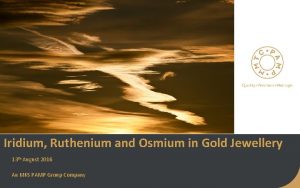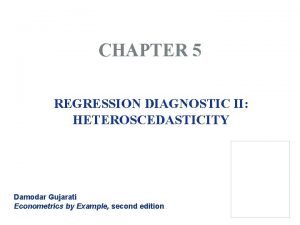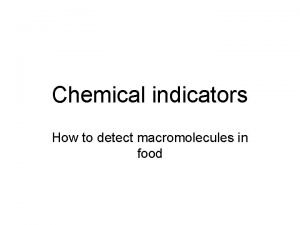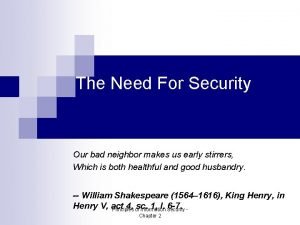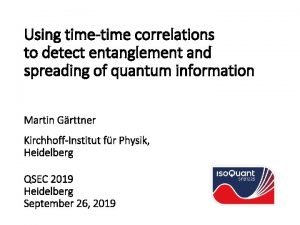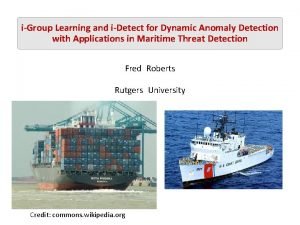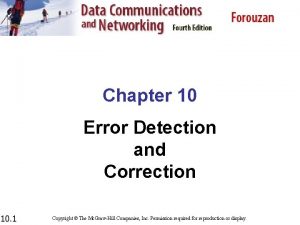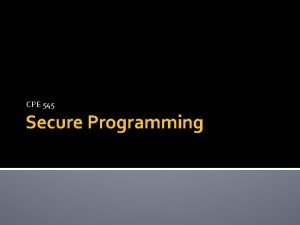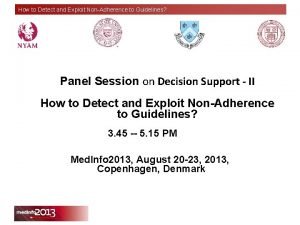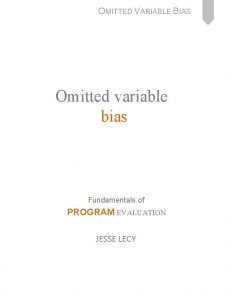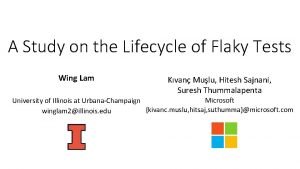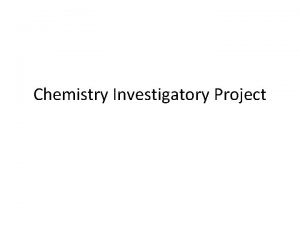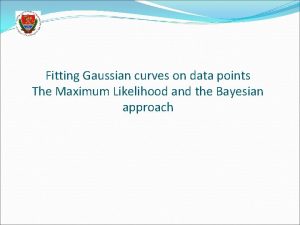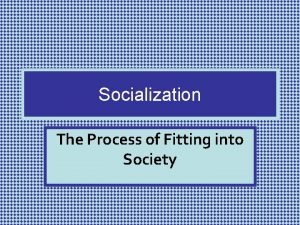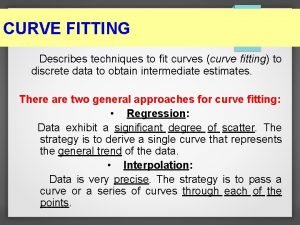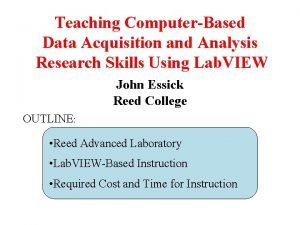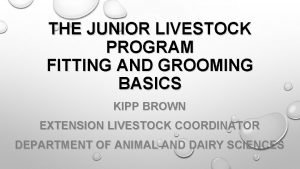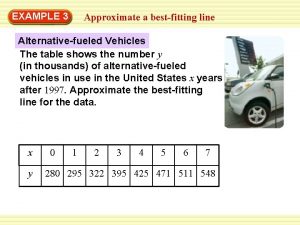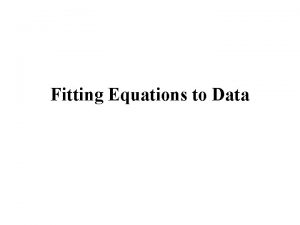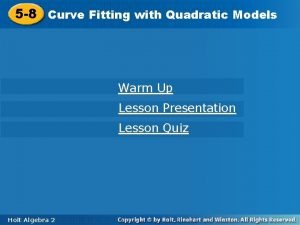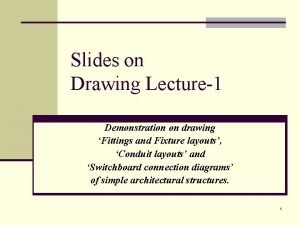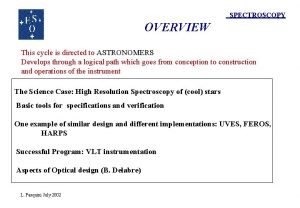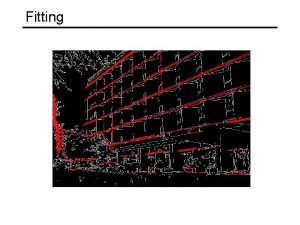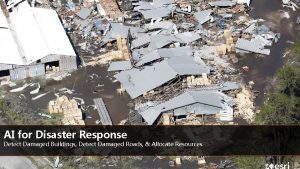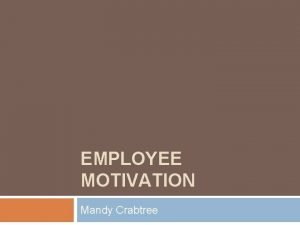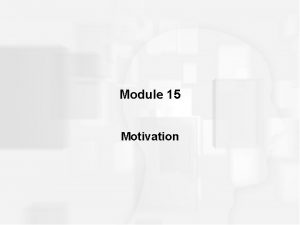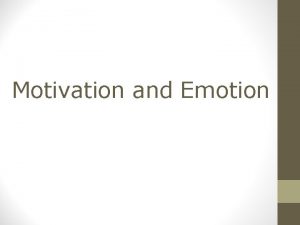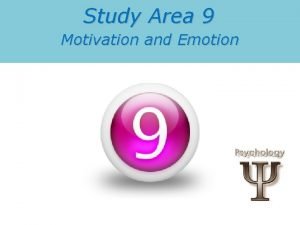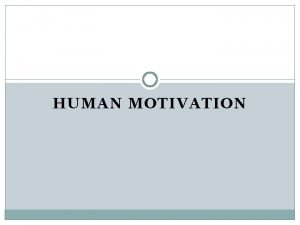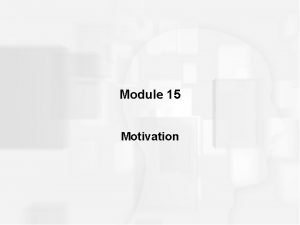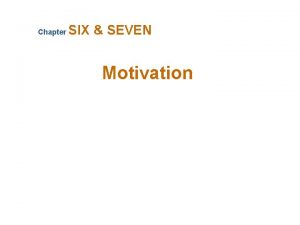Fitting Fitting Motivation Weve learned how to detect


































- Slides: 34

Fitting

Fitting: Motivation • We’ve learned how to detect edges, corners, blobs. Now what? • We would like to form a higher-level, more compact representation of the features in the image by grouping multiple features according to a simple model 9300 Harris Corners Pkwy, Charlotte, NC

Fitting • Choose a parametric model to represent a set of features simple model: lines simple model: circles complicated model: car Source: K. Grauman

Fitting • Choose a parametric model to represent a set of features • Line, ellipse, spline, etc. • Three main questions: • What model represents this set of features best? • Which of several model instances gets which feature? • How many model instances are there? • Computational complexity is important • It is infeasible to examine every possible set of parameters and every possible combination of features

Fitting: Issues Case study: Line detection • Noise in the measured feature locations • Extraneous data: clutter (outliers), multiple lines • Missing data: occlusions

Fitting: Issues • If we know which points belong to the line, how do we find the “optimal” line parameters? • Least squares • What if there are outliers? • Robust fitting, RANSAC • What if there are many lines? • Voting methods: RANSAC, Hough transform • What if we’re not even sure it’s a line? • Model selection

Least squares line fitting Data: (x 1, y 1), …, (xn, yn) Line equation: yi = m xi + b Find (m, b) to minimize y=mx+b (xi, yi)

Least squares line fitting Data: (x 1, y 1), …, (xn, yn) Line equation: yi = m xi + b Find (m, b) to minimize y=mx+b (xi, yi) Normal equations: least squares solution to XB=Y

Problem with “vertical” least squares • Not rotation-invariant • Fails completely for vertical lines

Total least squares Distance between point (xi, yi) and line ax+by=d (a 2+b 2=1): |axi + byi – d| ax+by=d (xi, Unit normal: yi) N=(a, b)

Total least squares Distance between point (xi, yi) and line ax+by=d (a 2+b 2=1): |axi + byi – d| Find (a, b, d) to minimize the sum of squared perpendicular distances ax+by=d (xi, Unit normal: yi) N=(a, b)

Total least squares Distance between point (xi, yi) and line ax+by=d (a 2+b 2=1): |axi + byi – d| Find (a, b, d) to minimize the sum of squared perpendicular distances ax+by=d (xi, Unit normal: yi) N=(a, b) Solution to (UTU)N = 0, subject to ||N||2 = 1: eigenvector of UTU associated with the smallest eigenvalue (least squares solution to homogeneous linear system UN = 0)

Total least squares second moment matrix

Total least squares second moment matrix N = (a, b)

Least squares as likelihood maximization • Generative model: line points are corrupted by Gaussian noise in the direction perpendicular to the line point normal on the noise: direction line sampled from zero-mean Gaussian with std. dev. σ ax+by=d (u, v) ε (x, y)

Least squares as likelihood maximization • Generative model: line points are corrupted by Gaussian noise in the direction perpendicular to the line ax+by=d (u, v) ε (x, y) Likelihood of points given line parameters (a, b, d): Log-likelihood:

Least squares for general curves • We would like to minimize the sum of squared geometric distances between the data points and the curve (xi, yi) d((xi, yi), C) curve C

Least squares for conics • Equation of a general conic: C(a, x) = a · x = ax 2 + bxy + cy 2 + dx + ey + f = 0, a = [a, b, c, d, e, f], x = [x 2, xy, y 2, x, y, 1] • Minimizing the geometric distance is non-linear even for a conic • Algebraic distance: C(a, x) • Algebraic distance minimization by linear least squares:

Least squares for conics • Least squares system: Da = 0 • Need constraint on a to prevent trivial solution • Discriminant: b 2 – 4 ac • Negative: ellipse • Zero: parabola • Positive: hyperbola • Minimizing squared algebraic distance subject to constraints leads to a generalized eigenvalue problem • Many variations possible • For more information: • A. Fitzgibbon, M. Pilu, and R. Fisher, Direct least-squares fitting of ellipses, IEEE Transactions on Pattern Analysis and Machine Intelligence, 21(5), 476 --480, May 1999

Least squares: Robustness to noise Least squares fit to the red points:

Least squares: Robustness to noise Least squares fit with an outlier: Problem: squared error heavily penalizes outliers

Robust estimators • General approach: minimize ri (xi, θ) – residual of ith point w. r. t. model parameters θ ρ – robust function with scale parameter σ The robust function ρ behaves like squared distance for small values of the residual u but saturates for larger values of u

Choosing the scale: Just right The effect of the outlier is minimized

Choosing the scale: Too small The error value is almost the same for every point and the fit is very poor

Choosing the scale: Too large Behaves much the same as least squares

Robust estimation: Notes • Robust fitting is a nonlinear optimization problem that must be solved iteratively • Least squares solution can be used for initialization • Adaptive choice of scale: approx. 1. 5 times median residual (F&P, Sec. 15. 5. 1)

RANSAC • Robust fitting can deal with a few outliers – what if we have very many? • Random sample consensus (RANSAC): Very general framework for model fitting in the presence of outliers • Outline • Choose a small subset of points uniformly at random • Fit a model to that subset • Find all remaining points that are “close” to the model and reject the rest as outliers • Do this many times and choose the best model M. A. Fischler, R. C. Bolles. Random Sample Consensus: A Paradigm for Model Fitting with Applications to Image Analysis and Automated Cartography. Comm. of the ACM, Vol 24, pp 381 -395, 1981.

RANSAC for line fitting Repeat N times: • Draw s points uniformly at random • Fit line to these s points • Find inliers to this line among the remaining points (i. e. , points whose distance from the line is less than t) • If there are d or more inliers, accept the line and refit using all inliers

Choosing the parameters • Initial number of points s • Typically minimum number needed to fit the model • Distance threshold t • Choose t so probability for inlier is p (e. g. 0. 95) • Zero-mean Gaussian noise with std. dev. σ: t 2=3. 84σ2 • Number of samples N • Choose N so that, with probability p, at least one random sample is free from outliers (e. g. p=0. 99) (outlier ratio: e) Source: M. Pollefeys

Choosing the parameters • Initial number of points s • Typically minimum number needed to fit the model • Distance threshold t • Choose t so probability for inlier is p (e. g. 0. 95) • Zero-mean Gaussian noise with std. dev. σ: t 2=3. 84σ2 • Number of samples N • Choose N so that, with probability p, at least one random sample is free from outliers (e. g. p=0. 99) (outlier ratio: e) proportion of outliers e s 2 3 4 5 6 7 8 5% 2 3 3 4 4 4 5 10% 3 4 5 6 7 8 9 20% 25% 30% 40% 5 6 7 11 17 7 9 11 19 35 9 13 17 34 72 12 17 26 57 146 16 24 37 97 293 20 33 54 163 588 26 44 78 272 1177 Source: M. Pollefeys

Choosing the parameters • Initial number of points s • Typically minimum number needed to fit the model • Distance threshold t • Choose t so probability for inlier is p (e. g. 0. 95) • Zero-mean Gaussian noise with std. dev. σ: t 2=3. 84σ2 • Number of samples N • Choose N so that, with probability p, at least one random sample is free from outliers (e. g. p=0. 99) (outlier ratio: e) Source: M. Pollefeys

Choosing the parameters • Initial number of points s • Typically minimum number needed to fit the model • Distance threshold t • Choose t so probability for inlier is p (e. g. 0. 95) • Zero-mean Gaussian noise with std. dev. σ: t 2=3. 84σ2 • Number of samples N • Choose N so that, with probability p, at least one random sample is free from outliers (e. g. p=0. 99) (outlier ratio: e) • Consensus set size d • Should match expected inlier ratio Source: M. Pollefeys

Adaptively determining the number of samples • Inlier ratio e is often unknown a priori, so pick worst case, e. g. 50%, and adapt if more inliers are found, e. g. 80% would yield e=0. 2 • Adaptive procedure: • N=∞, sample_count =0 • While N >sample_count – Choose a sample and count the number of inliers – Set e = 1 – (number of inliers)/(total number of points) – Recompute N from e: – Increment the sample_count by 1 Source: M. Pollefeys

RANSAC pros and cons • Pros • Simple and general • Applicable to many different problems • Often works well in practice • Cons • Lots of parameters to tune • Can’t always get a good initialization of the model based on the minimum number of samples • Sometimes too many iterations are required • Can fail for extremely low inlier ratios • We can often do better than brute-force sampling
 Weve got the beat
Weve got the beat Weve requiring
Weve requiring Weve got this
Weve got this We've a story to tell to the nations
We've a story to tell to the nations Weve been lied to
Weve been lied to Osmium jewelry
Osmium jewelry Detect font
Detect font Assumptions of clrm gujarati
Assumptions of clrm gujarati How are indicators used to detect macromolecules
How are indicators used to detect macromolecules Detect bad neighbor vulnerability
Detect bad neighbor vulnerability Detect font
Detect font How to detect heteroscedasticity
How to detect heteroscedasticity Detect study
Detect study Detect protect perfect
Detect protect perfect A simple parity check can detect
A simple parity check can detect Stack based overflow
Stack based overflow Policy non-compliance: exploit detection
Policy non-compliance: exploit detection Omitted variable bias
Omitted variable bias Silver ticket attack
Silver ticket attack How to detect flaky tests
How to detect flaky tests To detect the adulterants in fat oil and butter
To detect the adulterants in fat oil and butter Detect protect perfect
Detect protect perfect Detect hex color from image
Detect hex color from image Gaussian curve fitting
Gaussian curve fitting Dr comfort order forms
Dr comfort order forms Fitting into society
Fitting into society Curve fitting techniques
Curve fitting techniques Labview curve fitting
Labview curve fitting Steer clipping and fitting techniques
Steer clipping and fitting techniques How to approximate the best fitting line for data
How to approximate the best fitting line for data Fitting equations to data
Fitting equations to data Hot humid
Hot humid Curve fitting with quadratic models
Curve fitting with quadratic models Conduit layout diagram
Conduit layout diagram Main sequence fitting
Main sequence fitting





